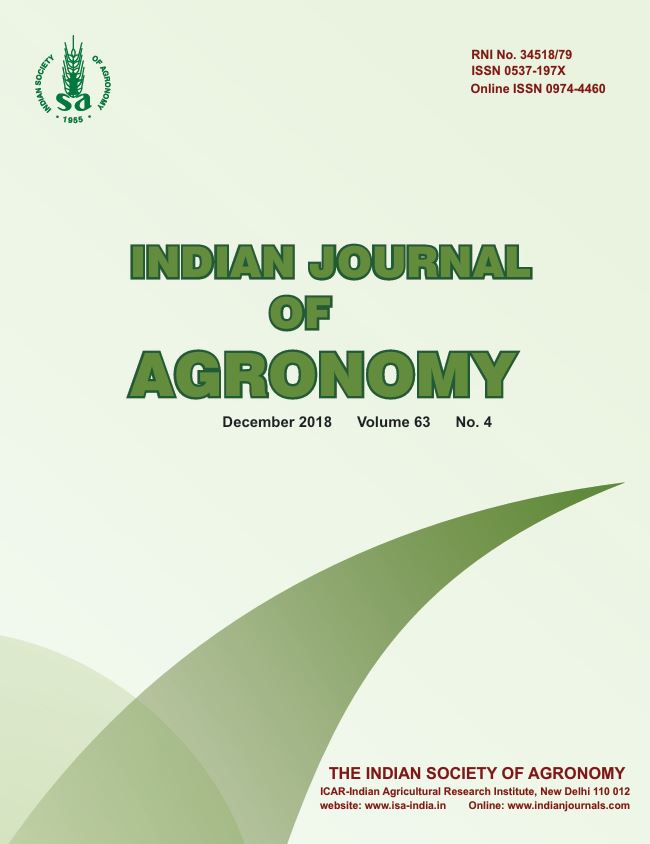Optimization of seeding rates and nitrogen scheduling in direct-seeded rice (Oryza sativa) under drought-prone environment in middle Indo-Gangetic plains
DOI:
https://doi.org/10.59797/ija.v63i4.5676Keywords:
Carbon output, Direct-seeded rice, Drought prone, Indo-Gangetic plains, Nitrogen scheduling, Seeding rateAbstract
A field experiment was conducted during the rainy (kharif) seasons of 2014 and 2015 at Patna, Bihar to optimise the seeding rates and nitrogen scheduling for direct-seeded rice (Oryza sativa L.) under the rainfed drought-prone environment. The soil of the experimental plot was loamy, low in organic carbon (0.42) and available N (149.6 kg/ha), high in available phosphorus (25.8 kg/ha), medium in available potash content (183.6 kg/ha) and slightly alkaline (pH 7.7). The treatments consisted of 3 seeding rates (S1: 20 kg/ha; S2 : 30 kg/ha; and S3 : 40 kg/ha) in main-plot and four nitrogen schedules (N1 , 1/3 N as basal and 2/3 N at maximum tillering; N2 , 1/3 N as basal and 1/3 N at maximum tillering and 1/3 N at panicle initiation; N3 , 1/2 N at first shower/enough moisture availability preferably after first weeding and 1/2 N at maximum tillering; and N4 , 1/3 N at first shower/enough moisture availability preferably after first weeding, 1/3 N at maximum tillering and 1/3 N at panicle initiation stage) in sub-plot and replicated thrice in split-plot design. The results revealed that the grain yield was significantly higher with S3 (3.2 t/ha) than that to S1 (2.4 t/ha), but statistically at par with that obtained with S2 (3.1 t/ha). Varying nitrogen schedules did not affect the grain yield markedly. Comparatively higher grain yield was recorded with N4 (3.0 t/ha) followed by N3 (2.94 t/ha) and N1 (2.87 t/ha). The gross returns (32.1 ×103 /ha), net returns (15.9 × 103 /ha) and benefit: cost ratio (1.64) were significantly higher with 40 kg/ha seed rate compared to 20 kg/ha ( 22.4 ×103/ha, 6.2 ×103/ha and 1.26 but statistically similar to 30 kg/ha ( 28.9 ×103 /ha, 13.4 ×103/ha and 1.55. The net returns were significantly higher with N4 closely followed by N3. Hence, growing of direct-seeded rice using 40 kg/ha seed rate along with split application of 1/3rd N at first shower/enough moisture availability preferably after first weeding, 1/3rd N at maximum tillering and 1/3rd N at panicle initiation stage is an ideal and sustainable approach in terms of productivity and profitability under rainfed drought-prone environment of Eastern India.
References
Ahmed, S., Salim, M. and Chauhan, B.S. 2014. Effect of weed management and seed rate on crop growth under direct dry seeded rice systems in Bangladesh. PLOSONE, https://doi.org/10.1371/journal.pone.010191
Gomez, K.A. and Gomez, A.A. 1984. Statistical Procedure for Agricultural Research, 2 edn., pp. 241–271. John Wiley & Sons, New York.
Gopalan, C., Sastri, R. and Balasubramaniam. 2004. Nutritive Value of Indian Foods (Revised Edn). National Institute of Nutrition, ICMR, Hyderabad, India. pp. 47–57.
Kumar, R., and Kumawat, N. 2014. Effect of sowing dates, seed rates and integrated nutrition on productivity, profitability and nutrient uptake of summer mungbean in Eastern Himalaya. Archives of Agronomy and Soil Science 60(9): 1,207–1,227.
Kumar, R., Deka, B.C. and Ngachan, S.V. 2015. Response of summer mungbean to sowing time, seed rates and integrated nutrient management. Legume Research 38(3): 348–352.
Kumar, R., Nandan, R., Kumar, V., Prasad, S. and Singh, D. 2009. Response of summer mungbean (Vigna radiata) cultivars to sowing time and seed rate. Indian Journal of Agricultural Sciences 79(4): 309–312.
Kumar, S., Kumar, R., Mishra, J.S., Dwivedi, S.K., Prakash, V., Bhkata, N., Singh, A.K., Singh, S.K., Haris, A.A., Rao, K.K., Mondal, S., Bhatt, B.P., Singh, S., Yadav, A. 2017. Evaluation of rice (Oryza sativa) cultivars under different crop establishment methods to enhance productivity, profitability and energetics of rice in middle Indo-Gangetic plains of Eastern India. Indian Journal of Agronomy 62(3): 307–314.
Kumar, S., Kumar, R., Mishra, J.S., Dwivedi, S.K., Prakash, V., Rao, K.K., Singh, A.K., Bhatt, B.P., Singh, S.S., Haris, A.A., Kumar, V., Srivastava, A.K., Singh, S. and Yadav, A. 2018. Productivity and profitability of rice (Oryza sativa) genotypes as influenced by crop management practices under middle Indo-Gangetic plains. Indian Journal of Agronomy 63(1): 45–49.
Kumawat, N., Singh, R.P., Kumar, R., Kumari, A. and Kumar, P. 2012. Response of intercropping and integrated nutrition on production potential and profitability of rainfed pigeonpea. Journal of Agricultural Science 4(7): 154–162.
Nwokwu, G., Babaji, B.A. and Dadari, S.A. 2015. Physiological indices of direct-seeded upland rice (Oryza species) varieties as affected by seed rates. International Journal of Science and Research 4(8): 2,319–7,064.
Singh, R.J. and Ahlawat, I.P.S. 2015. Energy budgeting and carbon footprint of transgenic cotton-wheat production system through peanut intercropping and FYM addition. Environmental Monitoring and Assessment 187(5): 1–16.
Singh, S.K., Abraham, T., Kumar, R. and Kumar, R. 2017. Response of crop establishment methods and split application of nitrogen on productivity of rice under irrigated ecosystem. Environment & Ecology 35(2A): 859–862.
Walia, U.S., Gill, G., Walia, S.S. and Sindhu, A.S. 2011. Production of direct-seeded rice (Oryza sativa) under differential plant densities and herbicides in central plains of Punjab. Journal of Crop and Weed 7(2): 1–5.
Xiaoli, Q., Wu, Wei., Shah, F., Peng, S., Huang, J., Cui, Kehui., Liu, Hongyan and Nie, L. 2011. Ammonia volatilization from urea-application influenced germination and early seedling growth of dry direct-seeded rice. Scientific World Journal. doi:10.1100/2012/857472.






